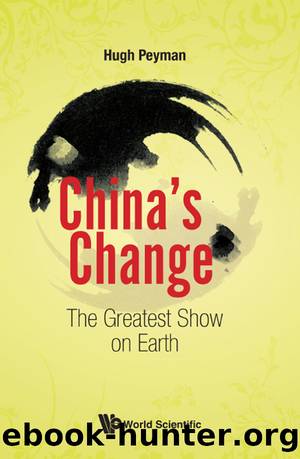China's Change: The Greatest Show on Earth by Hugh Peyman

Author:Hugh Peyman [Peyman, Hugh]
Language: eng
Format: epub
Tags: Asian, Political Science, World
ISBN: 9789813231429
Google: q39NswEACAAJ
Goodreads: 40773643
Publisher: World Scientific Publishing Co Pte Ltd
Published: 2018-01-15T07:05:19+00:00
Results
Results started to flow almost immediately. At the March National Peopleâs Congress (NPC), Chinaâs legislature, both military and academic delegates attacked leftism (economic conservatism). Military commanders of Chinaâs seven military regions visited Shenzhen and Zhuhai that spring, so did 57 generals. In May, five cities along the Yangzi opened up to foreign trade, receiving the same privileges as existing special economic zones. So did nine border cities and 30 prefecture cities. Shanghai was pronounced the economic dragon head of the Yangzi. This was all happening at dizzying speed.
To underline the total shift in official thinking, Jiang Zemin addressed the graduate class of the Central Party School, which educates the partyâs and hence Chinaâs future leaders. His subject was âDeeply Understand and Implement Comrade Deng Xiaopingâs Important Spirit, Make Economic Construction, Reform and Opening Go Faster and Betterâ. This was the equivalent of a US president addressing West Point on a major change in military policy, though without a snappy title like âPivot to Asiaâ.
Jiang said GDP growth should be raised to 9%â10%, well above the 6% five-year plan target conservative Li Peng had announced in March. China should look overseas for ideas and not bother discussing whether they were capitalist or socialist. Jiang boldly referred to this as a âsocialist market economyâ, in contrast to leading economic conservative Chen Yun who talked of a âplanned socialist market economyâ. When Jiang asked Deng if he liked his Party School speech, Deng replied, âActually, Shenzhen has a socialist market economy.â There was no need to talk any more about central planning.
The 1980s had increasingly revealed the limitations of earlier reform and its slowing pace, as Edward Steinfeld described in his 1998 book Forging Reform in China and subsequently Playing Our Game. Bolting on 1978âs Four Modernizations to the old system did not work. Fundamentally new structures and principles were needed. With a new âreform and opening upâ script, Jiang laid out four ideas at Octoberâs 14th Congress. There was no need to question any more if something was capitalist or socialist; while retaining state ownership as the main form, State-owned Enterprises (SOEs) could become more independent, with experiments done in shareholding structures; markets should be expanded beyond agriculture to all main sectors, including capital, technology, information and housing; and science and technology were now a âprimaryâ productive force. Economic reform was to accelerate.
Like any well-managed political convention, the star arrived at the end, but only after a long build-up to his entrance. Deng was praised by Jiang Zemin for all his contributions and the policies he advocated. The party veteran, and now its indisputably most powerful man, was 88 years old, an auspicious number for Chinese. This would most probably be Dengâs last party congress, his grand finale. No more speeches, just some very symbolic moments of continuity as he handed over power to the younger third generation before fading into the background.
The frail Deng entered the 14th Congress in the Great Hall of the People to a heroâs welcome. He immediately
Download
This site does not store any files on its server. We only index and link to content provided by other sites. Please contact the content providers to delete copyright contents if any and email us, we'll remove relevant links or contents immediately.
Incentives and Prosocial Behavior by Incentives & Prosocial Behavior(372)
Reframing Difference in Organizational Communication Studies: Research, Pedagogy, and Practice by Dennis K. Mumby (editor)(322)
Financial Markets, Public Policy, and the East Asian Miracle by Financial Markets Public Policy & the East Asian Miracle(278)
The 21 Irrefutable Truths of Trading: A Trader's Guide to Developing a Mind to Win by John Hayden(242)
Handbook of Intercultural Communication and Cooperation (9783666403279) by Unknown(239)
Human Security in Turkey by Alpaslan Özerdem Füsun Özerdem(234)
Human-Computer Interaction by unknow(223)
Fandom Analytics by Michael Lewis(217)
How the World Became Rich: The Historical Origins of Economic Growth by Mark Koyama & Jared Rubin(215)
Guns of the World by Unknown(213)
Inheritance and Wealth Inequality in Britain by Harbury Colin;Hitchins David;(212)
Food Security, Affordable Housing, and Poverty by Ahmet Suayb Gundogdu(201)
Asset Integrity Management Systems a Complete Guide - 2020 Edition (9780655989844) by Blokdyk Gerardus(192)
Creative problem solving for managers by Developing Skills for Decision Making & Innovation(189)
The Way of the Wall Street Warrior by Dave Liu & Adam Snyder(185)
Beyond Positivism, Behaviorism, and Neoinstitutionalism in Economics by Deirdre Nansen McCloskey(185)
The Delusions of Economics by Gilbert Rist;(178)
Diminishing Returns by Mark Blyth(172)
The Inclusion Toolbox by Jennifer A. Kurth & Megan Gross(170)
